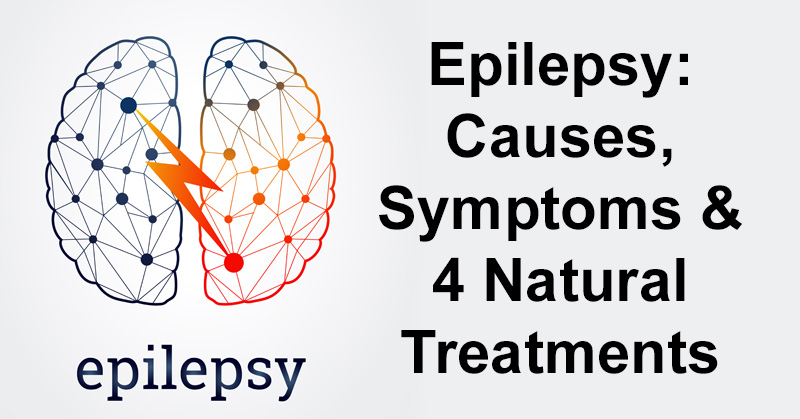Epilepsy is a neurological disorder in which brain activity becomes abnormal. Anyone can develop this condition. Epilepsy causes seizures or periods of unusual behavior, sensations, and sometimes loss of awareness. Other epilepsy symptoms include staring spells, as well as loss of awareness. Déjà vu and confusion are also common epilepsy symptoms. Genetics, head trauma, and prenatal injuries are just some of the possible epilepsy causes. Managing epilepsy symptoms can be a challenge. However, with epilepsy treatment methods in place, a reduction in frequency of episodes might be seen. Traditional epilepsy treatment methods include medication and possibly surgery. (1) Additionally, you might try a natural epilepsy treatment. For more information on what causes epilepsy, symptoms, as well as natural epilepsy treatment methods, read below.
Common causes of epilepsy: (2)
- Genetic influence: Certain genes could make a person more sensitive to environmental conditions that trigger seizures.
- Head trauma: If you’ve suffered head trauma, for example from a car accident or other traumatic injury, it could cause you to have epileptic episodes.
- Brain conditions: Brain tumors or strokes, or other brain conditions can be a culprit. In fact, stroke is a leading cause of this condition in adults over the age of 35.
- Infectious diseases: Certain infectious diseases, such as meningitis, AIDS and viral encephalitis, can all cause epileptic episodes.
- Prenatal injury: Before birth, babies are sensitive to brain damage that could be caused by various factors. These includes an infection in the mother, poor nutrition or oxygen deficiencies. This brain damage from these circumstances can result in seizures.
- Developmental disorders: Autism, neurofibromatosis and other developmental disorders can be associated with epileptic symptoms.
Common symptoms of epilepsy include:
- Temporary confusion
- A staring spell
- Uncontrollable jerking movements of the arms and legs
- Loss of consciousness or awareness
- Psychic symptoms such as fear, anxiety or deja vu
To help reduce epilepsy symptoms, try these 4 natural treatments:
1. Reduce Seizure Triggers

It’s not always possible to prevent a seizure from occurring. However, there are certain steps to help manage your individual triggers. This will help cut down on the odds of having a seizure.
Some seizure triggers to be aware of include: (3)
- Not taking epilepsy medicine as prescribed
- Feeling tired
- Not sleeping well
- Stress
- Alcohol and recreational drugs
- Flashing or flickering lights
- Monthly periods
- Missing meals
- Having an illness which causes a high temperature
2. A Ketogenic Diet

A ketogenic diet, or a very low-carb diet, has been used since the 1920s by doctors to help control their patients’ seizures. (4)
It isn’t entirely clear how the ketogenic diet works for seizure control. However, it leads to an increase in ketones in the blood. And increased ketones in the blood are associated with reduced seizure symptoms. (5)
If you wish to use this diet as a treatment, you can test whether or not you are are “in ketosis”. Being in ketosis means you are in the state of burning fat for fuel. You can test it by using strips at home and performing a urine test.
3. Vagus Nerve Stimulation
The vagus nerve passes through the neck and thorax to the torso. It regulates motor and sensory information. (6)
Vagus nerve stimulation therapy can help patients who have seizures. It involves implanting a nerve stimulator, about the size of a silver dollar coin, into the patient’s chest. The stimulator connects to the nerve and controls electrical energy flowing to and from the brain. When a patient with epilepsy experiences warning signs of a seizure, they can activate the stimulator with a magnet. It will help prevent the seizure from happening. (7) Researchers have found that this therapy type doesn’t work for every patient. However, it can still help reduce seizures on average by about 20 to 40 percent.
4. Emergency Care
It can be a frightening ordeal to be with someone while they are experiencing a seizure. However, if you educate yourself, you can know what to do to prevent injuries from occurring. (8)
What To Do If Someone Has A Seizure:
- Call an ambulance or seek medical help.
- Roll the person onto one side. Since they may vomit, rolling them to their side will help reduce the chance of choking.
- Try to place something under their head for padding. However, if you see any tight clothing around their neck, be sure to loosen it.
- If they move or shake, you may be tempted to restrain them. However, do not do this as this can lead to an injury. For example, you may dislocate their shoulder.
- Some people with severe seizures wear a bracelet to help identify themselves and warn of any condition, allergies or complications. If you don’t see one, try looking in their wallet for a card that states the same information.


